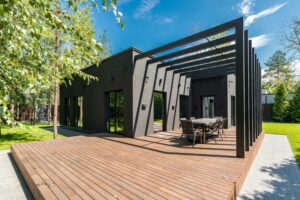Deck Board Size Guide: Choosing the Right Width and Thickness
By Dave KileMost homeowners don’t start a deck project thinking about board size. In my experience, they start with color, grain, or pattern instead. Board size is usually an afterthought, but it carries just as much weight, literally and figuratively, when it comes to your deck’s structure and design. From my side of the saw, board size influences the look of the deck surface and the framing it requires for strength and longevity.
In this guide, I’ll cover what board width and thickness mean for your deck, and how they tie into framing requirements, use, and safety. Looks may drive your board choice, but size sets the rules for your build.
Why Deck Board Size Matters
The width of a board helps shape the overall style of a deck, with narrow boards creating a more traditional look, while wider boards lean into a more modern, clean-lined feel. But looks are only part of the equation.
Width and thickness affect how far a board can span between joists, how much weight it can handle, and how solid it feels. Thinner boards may flex if joists aren’t spaced closely enough, while wider, heavier boards put more demand on the frame and may require larger joists or blocking for support. The right match between board size and framing is essential for a safe, sturdy deck.
how solid it feels. Thinner boards may flex if joists aren’t spaced closely enough, while wider, heavier boards put more demand on the frame and may require larger joists or blocking for support. The right match between board size and framing is essential for a safe, sturdy deck.
Regardless of size, consistent gaps between boards are always necessary. See my guide on deck spacing for best practices that allow for drainage and expansion.
Factors to Consider When Choosing Deck Board Size
Joist Spacing
Deck safety largely depends on proper joist spacing, and board thickness determines how far apart joists can be. In practice, most decks today are framed at 16″ on center (OC) because it delivers a sturdier surface, even though thicker boards may be rated for 24″ OC. Thickness still matters, though: it sets the maximum spacing allowed by code, and it comes into play with diagonal layouts and stair treads, for example.
For guidance, see the decking requirements in the American Wood Council’s DCA 6 guide, which provides span tables based on board size and joist spacing.
Deck Usage
 Think about how the deck will be used. Light foot traffic allows for thinner or narrower boards, while heavy furniture, hot tubs, or big gatherings demand more substantial thickness. High-traffic decks also benefit from thicker boards, which resist wear and feel more solid underfoot. For structural requirements, check manufacturer guidelines and DCA 6 codes to be sure your boards and the framing beneath can safely carry the deck load.
Think about how the deck will be used. Light foot traffic allows for thinner or narrower boards, while heavy furniture, hot tubs, or big gatherings demand more substantial thickness. High-traffic decks also benefit from thicker boards, which resist wear and feel more solid underfoot. For structural requirements, check manufacturer guidelines and DCA 6 codes to be sure your boards and the framing beneath can safely carry the deck load.
Climate is another factor: in regions with high moisture or freeze–thaw cycles, thicker boards hold up better against splitting and seasonal movement, while narrower boards may shed water and dry more quickly.
Material Type
Your choice of material changes what sizes are available and how they perform:
- Wood boards vary widely in performance; softer species like cedar and redwood are lighter and easier to handle, while hardwoods like Ipe or Tigerwood are denser, heavier, and naturally more durable. Very wide wood boards aren’t typically used for decking today because they’re prone to cupping from moisture.
- Composites and PVC boards are commonly 5.5” wide, but may be offered in wider and narrower boards for design flexibility. Joist spacing and span ratings vary by brand, so always consult the manufacturer.
- Aluminum decking is lightweight yet strong, and sold as interlocking plank systems that may include built-in drainage or non-slip surfaces.
No matter the decking material, don’t skip moisture protection. Using Trex Protect tape on wood joists, beams, and rims prevents water penetration, keeps fasteners secure, and extends the life of your frame. My guide on how to protect deck joists explains this critical step. When you’re ready, use the materials estimator to calculate how much Trex Protect you’ll need.
Pros and Cons of Different Board Sizes
Here are the pros and cons to weigh when choosing a deck board size:
- Narrow boards: Traditional look requiring more boards and fasteners. Faster drying since water reaches gaps more quickly.
- Wide boards: Cover more area faster with enhanced load-bearing capacity. Fewer gaps create a cleaner look, but wood can be more prone to cupping if moisture isn’t managed.
- Thicker boards: Handle heavier loads and longer spans and resist flexing, but are harder to handle and cost more.
- Thinner boards: Easier to handle and often less expensive, but limited in strength and durability.
One more detail I always point out is overhang. Boards should generally extend just enough to cover the rim joist; too much overhang can result in splitting. Check out my guide on deck board overhang rules for the safe limits.
Common Deck Board Sizes
I often see homeowners get tripped up by lumber sizing. A “2 × 6” isn’t really two inches by six, and if you’re not familiar with nominal sizes, that can be confusing. Lumber is sold by nominal labels, but the actual dimensions are smaller due to milling and finishing. Composite and PVC boards, on the other hand, are sold by their actual dimensions.
Here are the typical nominal board sizes you’ll encounter:
- 5/4 × 6 (actual ~1″ × 5.5″) – The most common for residential decks, designed for joists 16″ OC. Composite and PVC boards generally follow this 1” × 5.5” profile.
- 2 × 6 (actual ~1.5″ × 5.5″) – Heavier and stronger, rated for joist spans up to 24″ OC, though many builders still frame at 16″ OC.
- 1 × 6 (actual ~0.75″ × 5.5″) – Sometimes used in lighter applications or porch flooring, but not recommended for heavy loads.
Deck Board Size Chart
Here’s a quick reference to common deck board sizes, along with some less common options you may come across.
In most decking boards, thickness falls into three ranges: ~0.75″ (1× wood boards), ~1″ (5/4 wood, composites, and PVC), or ~1.5″ (2× lumber). The thicker the board, the farther it can span between joists without flexing. For code-approved spacing limits, see the decking requirements published by the American Wood Council.
|
|
|
|
|
|||||
| 1 × 4 Wood | ~0.75″ × 3.5″ | 3.5″ | 8’–16′ | Historically used for a traditional narrow-plank look. Uncommon in modern decks but sometimes chosen for restoration projects or design accents. | |||||
| 5/4 × 6 Wood | ~1″ × 5.5″ | 5.5″ | 8’–20′ | Standard residential decking board for joists spaced 16″ OC. | |||||
| 2 × 6 Wood | ~1.5″ × 5.5″ | 5.5″ | 8’–20′ | Stronger, heavier option; rated to span joists up to 24″ OC in many builds. Less common for residential decks due to weight and cost. | |||||
| 1 × 6 Wood | ~0.75″ × 5.5″ | 5.5″ | 8’–16′ | Lighter-use decking; less durable under heavy loads. More typical for porch flooring. | |||||
| Narrow composite/PVC | ~1″ × 3.5″ | 3.5″ | 12’–20’+ | A narrow-board option that creates a finer look with more seams. Used as design accents or in mixed-width layouts. | |||||
| Standard composite/PVC | ~1″ × 5.5″ | 5.5″ | 12’–20’+ | Standard for composite and PVC. Matches the classic look of wood decking but with lower maintenance. | |||||
| Wide composite/PVC | ~1″ × 7.25″ | 7.25″ | 12’–20’+ | Covers more surface quickly with fewer seams for a sleek look. May require specific framing per manufacturer. | |||||
| Aluminum decking systems | Varies by manufacturer | 6″–8″ typical | 12’–20’+ | Sold as systems at a higher upfront cost. Allows wider joist spacing, often 24″+ OC, with water resistance and high durability. |
Conclusion
The right deck board size balances strength, safety, and style. Consider how board width and thickness affect the look of your deck, along with its durability and load capacity. By weighing joist spacing, intended use, and aesthetics, you’ll land on the right combination for your project. Take your time, weigh your options, and make sure your new deck surface not only looks great but feels solid underfoot.
Sources
American Wood Council. (2015). Prescriptive residential wood deck construction guide.
Decks.com. (n.d.). Deck board dimensions: How to choose the right size.
Decks.com. (n.d.). Deck joist spacing for strong decking.
Family Handyman. (2022). Deck board spacing & sizing tips.
DecksDirect. (2023). Deck Board Profiles and Sizes.
